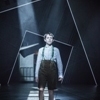Theatre Review - Emil and the Detectives
By Erich Kästner, adapted by Carl Miller
A National Theatre Production, directed by Bijan Scheibani
 Erich Kästner’s 1929 tale of Emil Tischbein’s quest to retrieve his money stolen by the mysterious Mr Snow has long held the status of a “children’s classic”. In his introduction to the 1959 English-language edition, Walter de la Mare stressed the universality of Emil’s adventure, while former Children’s Laureate Michael Rosen has noted how groundbreaking Kästner’s story was. Emil and the Detectives, he argues, was the “first book for children which treats the city as a place of excitement and worth” and which delighted, almost anarchically, in its depiction of “children coming together for a common purpose, without the guidance of adults”. For many, then (including myself) Emil and the Detectives was a seminal work of childhood – and the news of the National Theatre’s production prompted both excitement and anxiety. Could Emil’s adventure – essentially an extended chase sequence across a lovingly detailed Weimar Berlin – ever be successfully represented on stage?
Erich Kästner’s 1929 tale of Emil Tischbein’s quest to retrieve his money stolen by the mysterious Mr Snow has long held the status of a “children’s classic”. In his introduction to the 1959 English-language edition, Walter de la Mare stressed the universality of Emil’s adventure, while former Children’s Laureate Michael Rosen has noted how groundbreaking Kästner’s story was. Emil and the Detectives, he argues, was the “first book for children which treats the city as a place of excitement and worth” and which delighted, almost anarchically, in its depiction of “children coming together for a common purpose, without the guidance of adults”. For many, then (including myself) Emil and the Detectives was a seminal work of childhood – and the news of the National Theatre’s production prompted both excitement and anxiety. Could Emil’s adventure – essentially an extended chase sequence across a lovingly detailed Weimar Berlin – ever be successfully represented on stage?
Clearly aware of the affection in which his source material is held, Carl Miller’s adaptation treads a careful yet playful line between faithfulness and departure. Thankfully preserving the original’s lack of sentiment and overt moralizing, Miller’s is a witty retelling, bravely keeping the focus on the children, while also probing more deeply into the historical and political context of Kästner’s story. Under Bijan Scheibani’s direction, the momentum of Kästner’s work is beautifully preserved, as Emil hurtles from his home in the provincial Neustadt to the dynamic cityscape of Berlin, perfectly capturing Kästner’s sense of the thrill and fear of being a child in a metropolis: “The city was so large, and Emil was so small”. The production excels in its stylized depiction of Berlin, at once symbolically and cinematically represented by Bunny Christie’s extraordinary design, involving a set that morphs from a strip of celluloid, to a camera lens, to a metropolitan skyline of futuristic proportions. As Mr Snow says in the play, here, truly, the buildings “have to be fastened to the sky”.
The cue for this cinematic presentation of Berlin is cleverly taken from Kästner’s original, which repeatedly describes Emil’s experiences as a form of movie adventure: “Are we making a film? Do we need an audience?” For children, this staging reveals the dynamism of the city that Kästner revels in describing, while for adults there is the extra pleasure in noting multiple cinematic references, from those directly relating to the culture of Weimar Germany (including Walter Ruttmann’s Berlin. Die Sinfonie der Großstadt and Fritz Lang’s Metropolis), to Hitchcock and Carol Reed’s The Third Man (whose sewer-chase sequence is lovingly evoked.)
Adults and older children are also given the opportunity to explore the challenging historical context that lies behind Emil’s adventure. The legacy of the First World War and the political crises of the interwar years are deftly referenced, while the rise of fascism is made an explicit theme, powered by Miller’s access to hindsight. In a change from the original text, the team of Berlin children that come to Emil’s aid directly reveal their political affiliations to the left or right wing, while on the streets a chorus of adults chillingly expose the political and moral decay at the heart of Weimar German culture. While some reviewers have worried that a fundamental innocence in Kästner has been lost with these changes, the incorporation of the historical context has been carefully pitched – accessible by adults and those children old enough to engage with it, but never detracting from the fundamental exuberance of Kästner’s positive vision of children coming together to outwit all their elders.
The production judges this level of exuberance perfectly, and in the second half genuinely delighted its audience when the children’s pursuit of Mr Snow veered off the Olivier’s stage to occupy the entire theatre, with the public cheering on Emil and, in the denouement, scrabbling for the banknotes that came fluttering down from on high, so that they could return Emil’s money to its rightful owner. These are moments of sheer theatrical joy, which capture effortlessly the energy of the original.
This is certainly a more knowing version of Emil and the Detectives than Kästner perhaps envisaged – a knowingness underpinned by our own knowledge of the fate of Weimar Berlin and Germany more widely in the 1930s and 40s. Yet by expertly balancing this historical context with a celebration of childhood exuberance and innocence, the National Theatre’s production moves rapidly beyond the status of “mere” children’s show, to become an unexpectedly nuanced dramatic work that speaks to multiple audiences and – vitally – doesn’t need to rely on the public’s existing love of its source material to ensure its own success. 
Emil and the Detectives is at the National Theatre until 18th March 2014.
Benedict Schofield, King’s College London
[Top: Judy Flynn (Mrs Keuchen), Stuart McQuarrie (Mr Snow), Daniel Patten (Emil), Ella Kenion (Mrs Jakob); Middle: Daniel Patten (Emil); Bottom: Oliver Clement (The Professor) and Daniel Patten (Emil). All photos by Marc Brenner]


